Spring Migration 2021
Track the latest arrivals throughout spring 2021

Spring Migration is underway! Many people are out birding locally during lockdown, and, as the days get longer, they are reporting the first spring migrants. See what's happening and join in. Below you will find:
*First Arrivals Map
*First Arrivals Table
*Individual Species section
Track the first reports of nearly 50 species, some of which are common, such as Swallow, and some that are much more unusual, scarce migrants such as Hoopoes and Golden Orioles. For the scarce and rarer migrants, we provide realtime news year-round, whereas for the commoner migrants, we track Spring arrival only.
Please submit your records for species not yet recorded this spring, and for species that have only just arrived.
First Arrivals Map
This map shows the first report for each species, with an expandable key, on the left side of the map's top bar, giving details.
First Arrivals Table
| Species | First reported date | Site | County | |
| median 2002-20 | 2021 | |||
| Quail | 14-Apr | 9-Apr | Weston-super-Mare | Somerset |
| Garganey | 27-Feb | 22-Feb | Woolston | Cheshire and Wirral |
| Nightjar | 2-May | 30-Apr | Cogden Beach | Dorset |
| Swift | 31-Mar | 19-Mar | St.Catherine's Pt | Isle of Wight |
| Cuckoo | 21-Mar | 17-Mar | Stowmarket | Suffolk |
| Turtle Dove | 6-Apr | 5-Apr | Hindolveston | Norfolk |
| Corncrake | 18-Apr | 7-Apr | Frobost, South Uist | W.Isles |
| Stone Curlew | 17-Mar | 21-Feb | Farlington | Hampshire |
| Little Ringed Plover | 4-Mar | 25-Feb | Chesterfield | Derbyshire |
| Dotterel | 6-Apr | 11-Apr | Malham Tarn | North Yorks |
| Wood Sandpiper | 8-Apr | 1-Apr | Titchfield Haven HWT | Hants |
| Little Tern | 6-Apr | 30-Mar | Church Norton | West Sussex |
| Roseate Tern | 20-Apr | 26-Apr | Coquet Island | Northumberland |
| Common Tern | 22-Mar | 15-Mar | Tresco | Isles of Scilly |
| Arctic Tern | 3-Apr | 11-Apr | Thurlestone Bay | Devon |
| Black Tern | 12-Apr | 18-Apr | Attenborough NR | Notts |
| Night Heron | 2-Apr | 7-Mar | Nanjizal | Cornwall |
| Purple Heron | 3-Apr | 2-Apr | North Fambridge | Essex |
| Osprey | 4-Mar | 20-Feb | Orpington | London |
| Honey Buzzard | 20-Apr | 11-Apr | Copmanthorpe | North Yorks |
| Hoopoe | 14-Mar | 6-Mar | St.Agnes | Isles of Scilly |
| Hobby | 28-Mar | 20-Mar | Great Linford | Bucks |
| Golden Oriole | 21-Apr | 24-Apr | St.Mary's | Isles of Scilly |
| Sand Martin | 28-Feb | 19-Feb | Cardiff | Glamorgan |
| Swallow | 23-Feb | 16-Feb | Ruan Minor | Cornwall |
| House Martin | 8-Mar | 27-Feb | Long Sutton | Lincolnshire |
| Wood Warbler | 10-Apr | 7-Apr | Coldwaltham | West Sussex |
| Willow Warbler | 12-Mar | 4-Mar | Portland Castle | Dorset |
| Sedge Warbler | 24-Mar | 8-Mar | Christchurch | Dorset |
| Reed Warbler | 1-Apr | 30-Mar | Ham Wall RSPB | Somerset |
| Grasshopper Warbler | 2-Apr | 30-Mar | Christchurch | Dorset |
| Garden Warbler | 3-Apr | 31-Mar | Linford Gravel Pits | Buckinghamshire |
| Lesser Whitethroat | 2-Apr | 31-Mar | Lakenheath Fen RSPB | Suffolk |
| Whitethroat | 30-Mar | 21-Mar | Bovey Tracey | Devon |
| Ring Ouzel | 5-Mar | 1-Mar | Lodmoor RSPB | Dorset |
| Spotted Flycatcher | 17-Apr | 24-Apr | Porth Hellick, St.Mary's | Isles of Scilly |
| Bluethroat | 31-Mar | 12-Apr | Carr Vale NR | Derbyshire |
| Nightingale | 4-Apr | 29-Mar | Fordwich | Kent |
| Pied Flycatcher | 1-Apr | 30-Mar | Wyre Forest | Worcestershire |
| Redstart | 22-Mar | 27-Mar | Dagenham Chase LNR | London |
| Whinchat | 1-Apr | 25-Mar | Berryhill Fields | Staffordshire |
| Wheatear | 28-Feb | 10-Feb | West High Down | Isle of Wight |
| Yellow Wagtail | 20-Mar | 23-Mar | Elmley NNR | Kent |
| Blue-headed Wagtail | 6-Apr | 29-Mar | Southease | East Sussex |
| White Wagtail | 28-Feb | 21-Feb | Foreness Point | Kent |
| Tree Pipit | 24-Mar | 14-Mar | Ventnor | Isle of Wight |
| Common Rosefinch | 5-May | 25-May | Loch of Spiggie | Shetland |
Individual Species Accounts
Quail
Median first report 2002-2020: 14 Apr
This year's first report: 9 Apr - Sand Point, Weston-super-Mare, Somerset.
Occasionally, Quail are reported in March but early birds prior to mid April are likely to be either escapes from captivity, including non-native Japanese Quail such as one at Flamborough, Yorkshire in March 2016, or they could possibly be overwintering birds. Quail typically arrive much later, from late April into May. Despite being seemingly weak flyers and wintering in North Africa, historically Quail were a common bird in the UK, but their population has been in freefall since 1800, or earlier. Recent studies showed the UK breeding population, at less than 500 pairs, is again in decline since the 90's, following a modest rebound in the decades since the 2nd world war. The European population is estimated to be around 2 million pairs (1.3m - 2.7m).
arrivals map - upload a photo - report a sighting - latest news reports
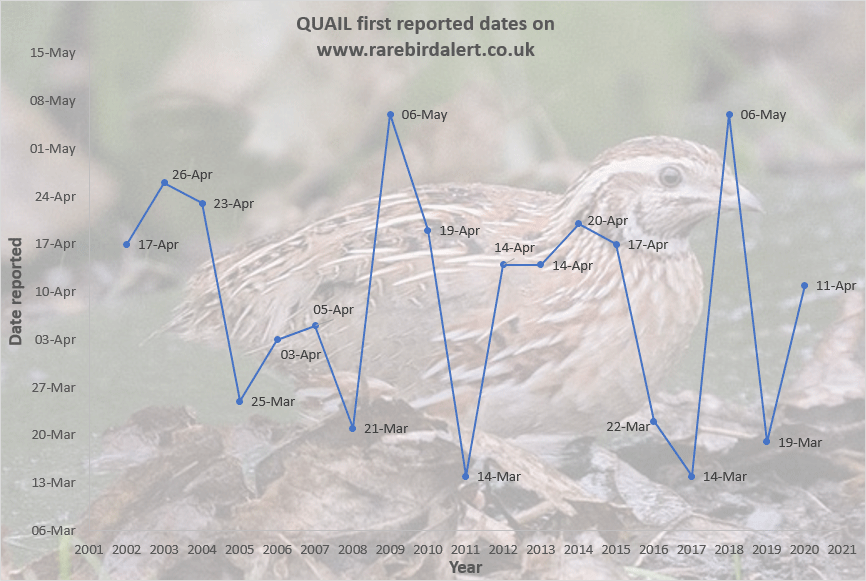
Garganey
Median first report 2002-2020: 27 Feb
This year's first report: 22 Feb - Woolston Eyes Nature Reserve, Cheshire.
The one at Woolston Eyes in Cheshire is five days earlier than the median first arrival date of the last 20 years. There had not been a Garganey at the site during the winter, so it's likely that this bird was a genuine Spring arrival. However, there are usually a few wintering Garganey in the UK, so early reported birds could potentially refer to those rather than long distance migrants. For example, in the winter of 2020/21, Garganey were recorded in Cambridgeshire, Carmarthenshire, Cheshire, Glamorgan, South Yorkshire, and Somerset. Spring migration occurs throughout March and into May.
arrivals map - upload a photo - report a sighting - latest news reports
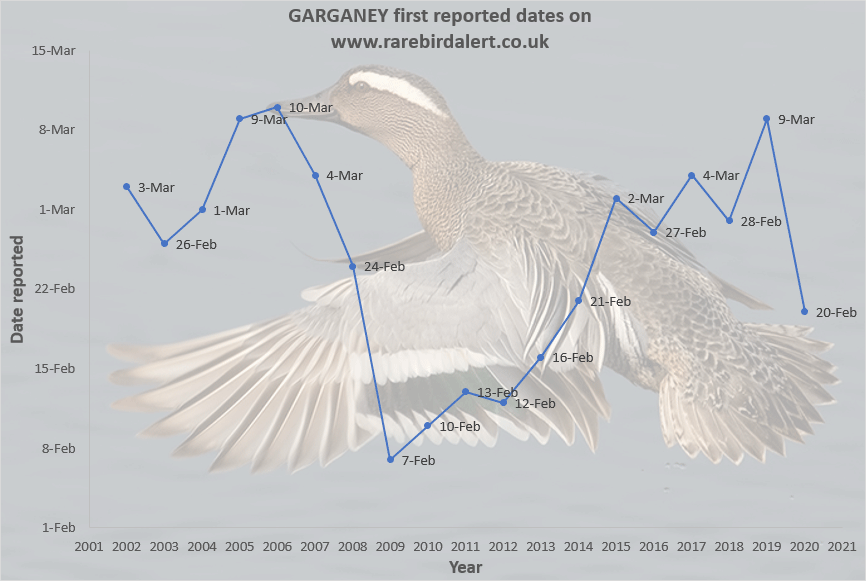
Nightjar
Median first report 2002-2020: 2 May
This year's first report: 30 Apr - Cogden Beach, Dorset.
There are very few reports of this obligate moth feeder before the influx in May, with most not seen until they arrive at their breeding grounds later in May or early June. Generally, we do not report them at breeding sites, to help minimise the risk of breeding failure due to disturbance. If you choose to visit a Nightjar breeding area, be sure to minimise your impact in every way possible, including never letting a dog off the lead at any time of day where any ground nesting species may be present. Recent estimates show around 4,500 pairs in Britain, approximately 1% of the European breeding population, which is estimated at around half a million pairs.
arrivals map - upload a photo - report a sighting - latest news reports
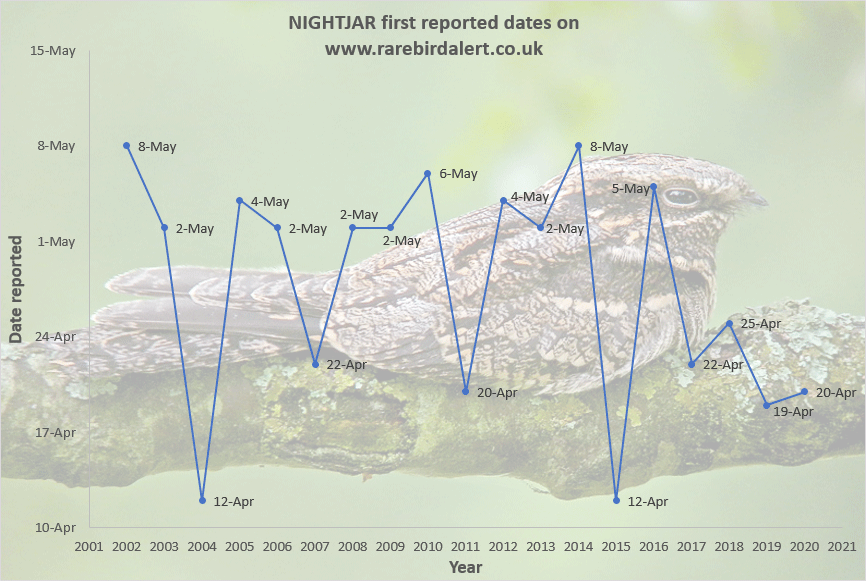
Swift
Median first report 2002-2020: 31 Mar
This year's first report: 19 Mar - St.Catherine's Point, Isle of Wight
March and early April Swifts are few and far between, and the possibility of vagrant Pallid Swift should be considered for such birds, and most years it is not until the third week of April that more than one or two have been seen. However, they then normally arrive in a rush, at the very end of the month and in the first few days of May, but if the weather is not favourable for flying insects they may leave en masse to feed in the Low Countries. Some non-breeding Swifts, 2nd-calendar-year birds, may arrive in the UK in late May, further boosting numbers. However, Swifts, like so many other birds, are not doing well in the UK, with a decline of over 50% since 1995.
arrivals map - upload a photo - report a sighting - latest news reports
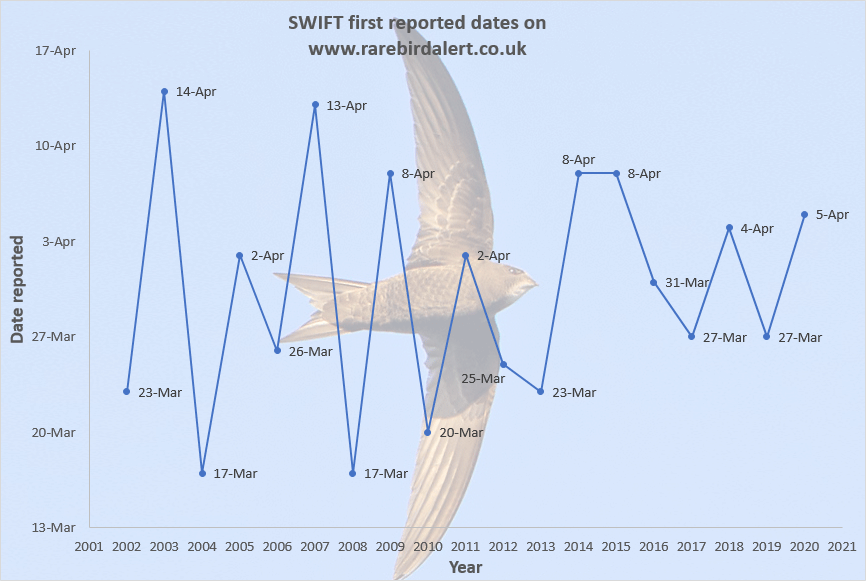
Cuckoo
Median first report 2002-2020: 21 Mar
This year's first report: 17 Mar - Stowmarket, Suffolk
Late March reports are few and far between and some may be the result of eagerness to get 'that letter' published in The Times. Unfortunately this is another species in serious decline, with a loss of over 50% of the UK population in the first 20 years of this century. Well worth a look is the BTO project that is tracking individual Cuckoo journeys to Africa and back. It is a data-heavy page, so can take a little longer to load. BTO Cuckoo tracking
arrivals map - upload a photo - report a sighting - latest news reports
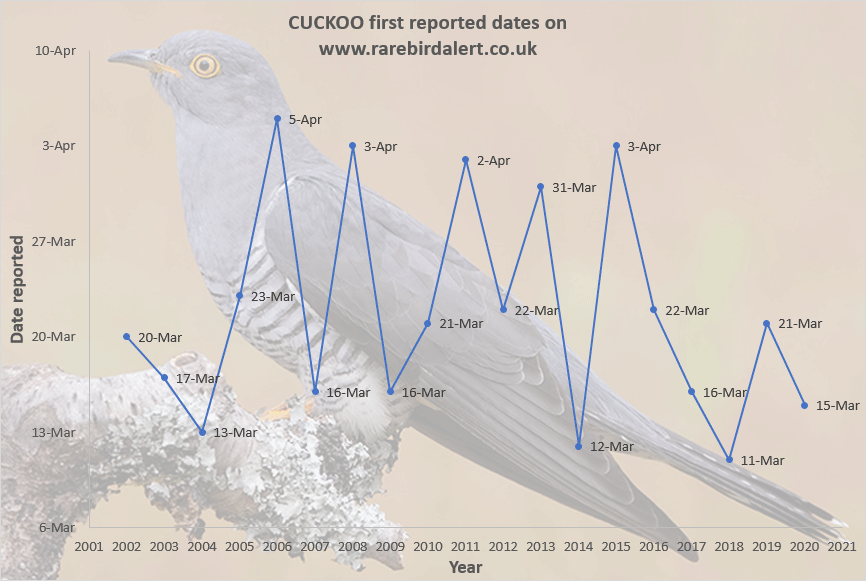
Turtle Dove
Median first report 2002-2020: 6 Apr
This year's first report: 5 Apr - Hindolveston, Norfolk.
March reports are exceptional, and some, if not all, could refer to wintering birds, so we try to exclude known wintering birds from arrival dates. The trickle of genuine migrants normally starts in the 2nd week of April. The big story of Turtle Doves, sadly, is of a species in serious trouble. Rangewide declines are thought to be driven by a number of factors including loss of foraging and nesting sites, disease and hunting along migration routes. Incredibly, France still permits the slaughter of tens of thousands annually.
arrivals map - upload a photo - report a sighting - latest news reports
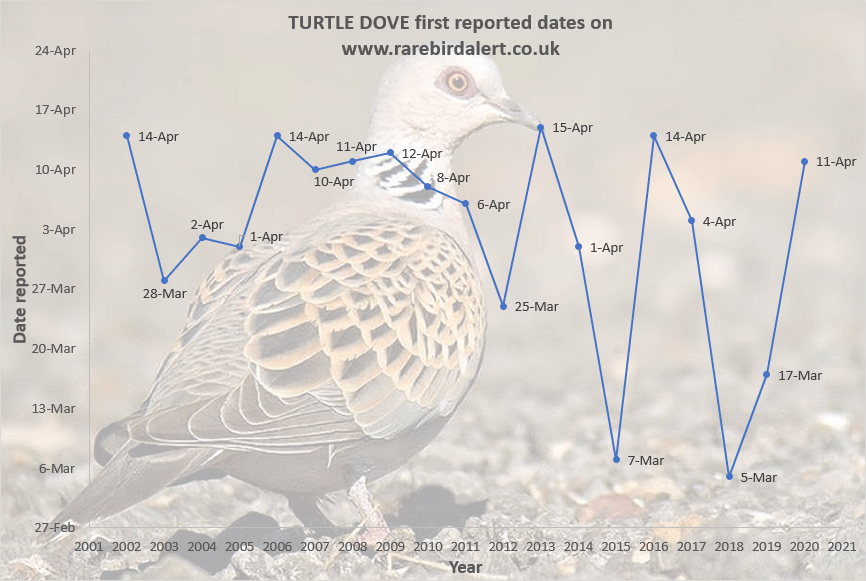
Corncrake
Median first report 2002-2020: 18 Apr
This year's first report: 7 Apr 2021 - Frobost, South Uist, Western Isles.
Corncrakes tend to arrive in the latter half of April into early May but are often not recorded on northbound migration, rather they are only located once they have arrived on their breeding grounds. Unsurprisingly, they have declined immensely in the UK over the past two centuries, doubtless due in great part to changing agricultural practices. Since the 1990s targeted conservation efforts, including release schemes, had dramatically reversed that decline, and by 2014 there were 1,333 singing males recorded. However, in both 2017 and in 2018 that new high was down by 30%, to just over 900. The vast majority of UK Corncrakes breed in northwestern Scotland, most of them on Tiree or the Outer Hebrides, whilst the release schemes in England accounted for a total of 25 calling males in 2018, representing about 3% of the overall total. The European population was recently estimated at a little under half a million pairs (300k-500k).
arrivals map - upload a photo - report a sighting - latest news reports
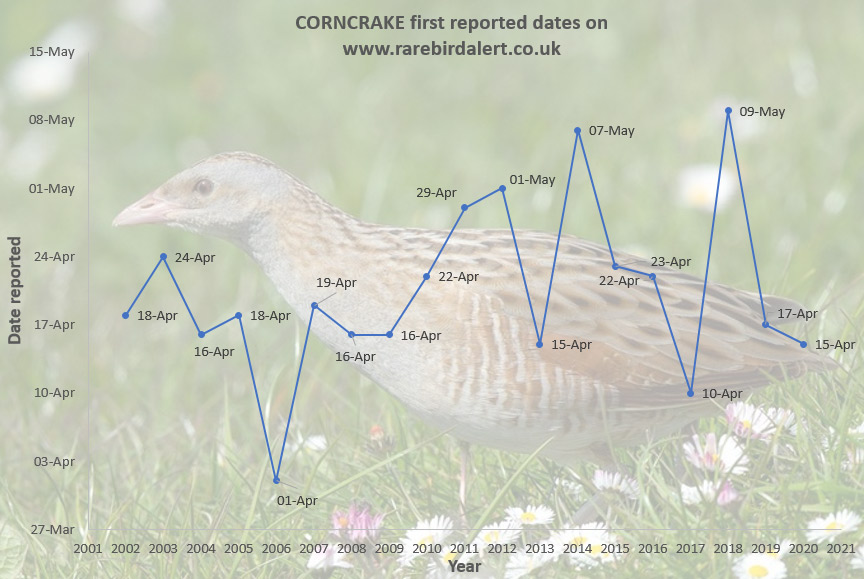
Stone Curlew
Median first report 2002-2020: 17 Mar
This year's first report: 21 Feb 2021 - Farlington Marshes HWT, Hampshire.
The individual on 21 February at Farlington Marshes HWT, Hampshire, is the 3rd-earliest first-report since 2002 and is well ahead of the median date. However, with occasional reports of wintering birds in the past, it is not easy to be sure of any early report being a migrant. This is a rare breeding species in the UK, there are believed to be around 300-400 pairs, so in order to help protect against disturbance we only report migrant birds away from breeding areas, unless the site is wardened and accepts/encourages visitors.
arrivals map - upload a photo - report a sighting - latest news reports
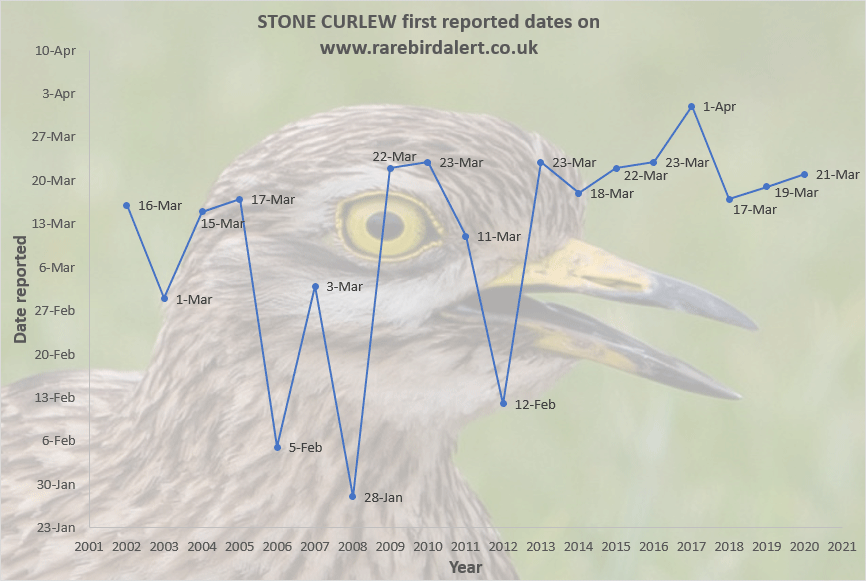
Little Ringed Plover
Median first report 2002-2020: 4 Mar
This year's first report: 25 Feb - Chesterfield, Derbyshire.
The bird on 25th February in Chesterfield, Derbyshire, was several days earlier than the median first-reported date for the species. As it is a fairly widespread breeding species, particularly in England, the early reported arrivals are often, inevitably, reported from breeding sites. Therefore, we stop featuring this species comparatively early in the season. The UK population accounts for about 1% of the European total which is estimated at about 100,000 pairs.
arrivals map - upload a photo - report a sighting - latest news reports

Dotterel
Median first report 2002-2020: 6 Apr
This year's first report: 11 Apr - Malham Tarn, North Yorks
An individual on 22nd February 2021 at St.Buryan, Cornwall, may well have overwintered undetected nearby. If not, it would be one of the earliest migrant Dotterels, and is five weeks earlier than the median date of migrants reported to RBA. It is likely that all late February/early March records could involve overwintering birds, either locally or on the near continent. A Dotterel at Cley, Norfolk in the winter of 1986/87 was not seen after the exceptionally heavy snow of mid January, when much of southeast England was buried under 50cm - 75cm.
arrivals map - upload a photo - report a sighting - latest news reports

Wood Sandpiper
Median first report 2002-2020: 8 Apr
This year's first report: 1 Apr - Titchfield Haven HWT, Hants.
This species occasionally overwinters, although a bird present at Old Moor RSPB, Yorkshire, throughout December 2020, wasn't reported after the New Year. However, what may have been the same individual was at Lound, Nottinghamshire on 3rd February 2021. There is a very small breeding poulation in the UK, of a few tens of pairs; the European population is estimated at around 300,000 pairs.
arrivals map - upload a photo - report a sighting - latest news reports
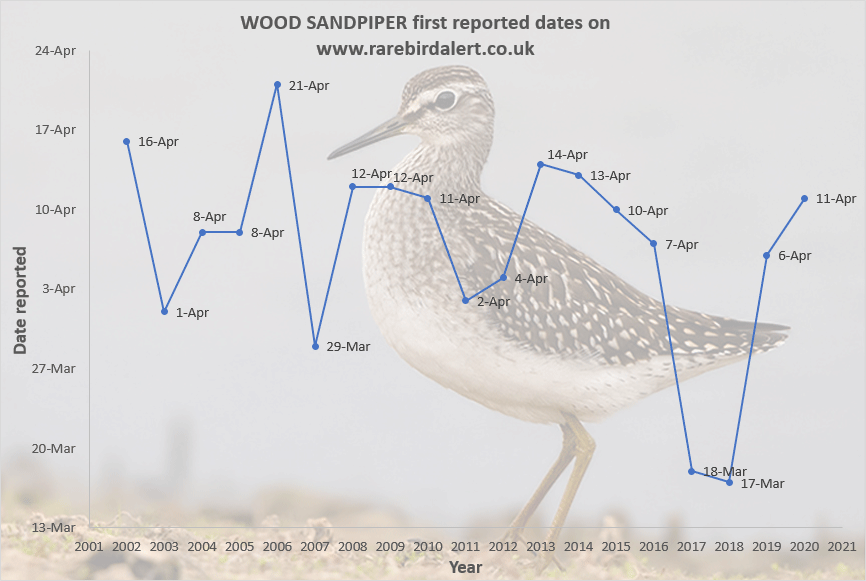
Little Tern
Median first report 2002-2020: 6 Apr
This year's first report: 30 Mar 2021 - Church Norton, West Sussex.
You can set your calendar by this early April arrival: almost every year, the first ones are reported in the week commencing 3rd April, with not a single one reported to RBA in March in the past 20 years. Will Climate Change influence that? And how will rising sea levels affect their breeding sites, which are especially subject to inundation in storms as well as disturbance by dogs and other influences.
arrivals map - upload a photo - report a sighting - latest news reports
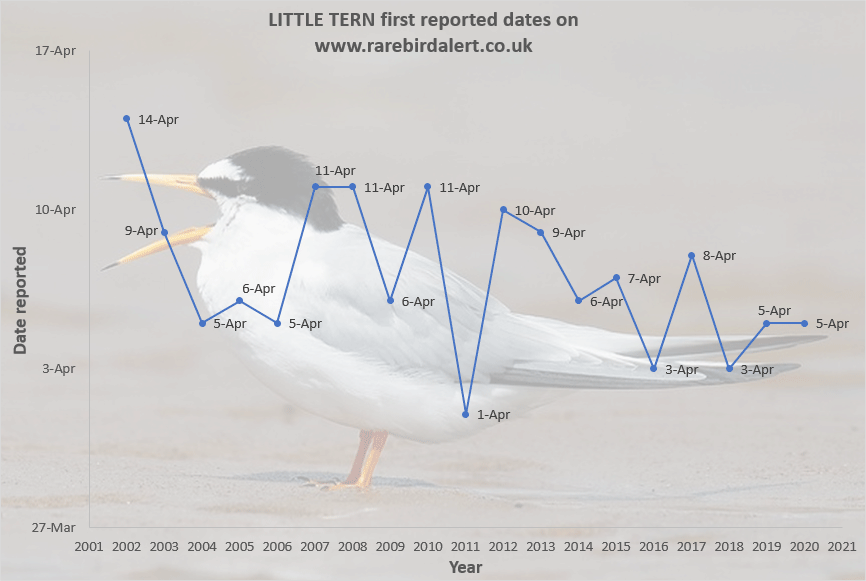
Roseate Tern
Median first report 2002-2020: 20 Apr
This year's first report: 26 Apr - Coquet Island, Northumberland.
The first Roseate Terns consistently arrive in British/Irish waters in the 3rd week of April, with most back by mid May. They are incredibly rare here in winter - although one was in Dublin in winter 2006/07. There are only around 100 pairs in Britain, and just 2,000 pairs in Europe in total, but of that, 1,600 are on the island of Rockabill, Co Dublin.
arrivals map - upload a photo - report a sighting - latest news reports
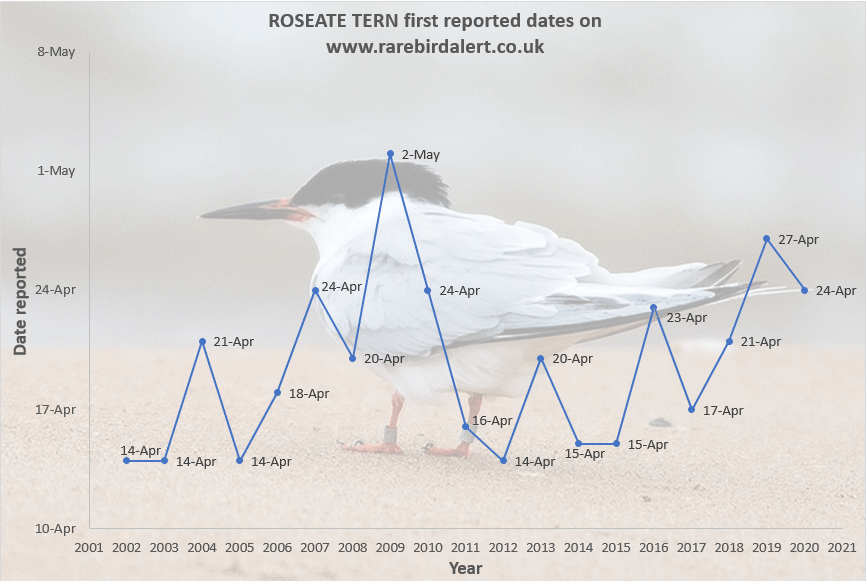
Common Tern
Median first report 2002-2020: 22 Mar
This year's first report: 15 Mar - Tresco, Isles of Scilly.
Overwintering birds are very rare. Most years a few have been reported by the end of March, with an occasional one earlier, but it's April before the main arrival, and most of the 11,000 or so breeding pairs have arrived by mid May.
arrivals map - upload a photo - report a sighting - latest news reports
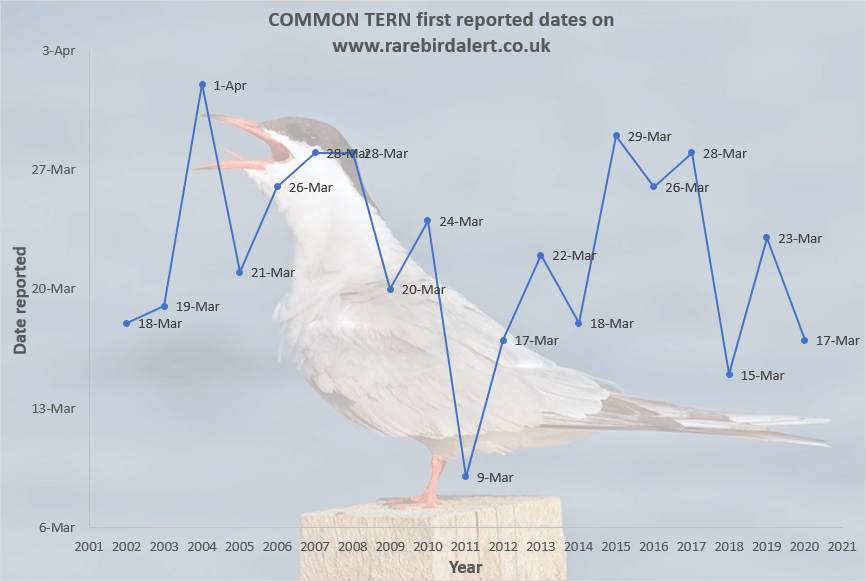
Arctic Tern
Median first report 2002-2020: 3 Apr
This year's first report: 11 Apr - Thurlestone Bay, Devon.
There are only a very few late March/early April reports: Arctic Terns are not necessarily an easy ID, even for expert eyes, especially if views are poor, and many birders choose to record such sightings as "Commic" Terns i.e. either Arctic or Common Tern. Some 10% of the European population are estimated to breed in Britain. Arctic Terns have incredible long-distance migrations, with many heading to Antarctic waters SW of Australia. One individual ringed as a chick on the Farne Islands, Northumberland, in June 1982 had made it to Melbourne, Australia, some 14,000 miles by sea, by October.
arrivals map - upload a photo - report a sighting - latest news reports
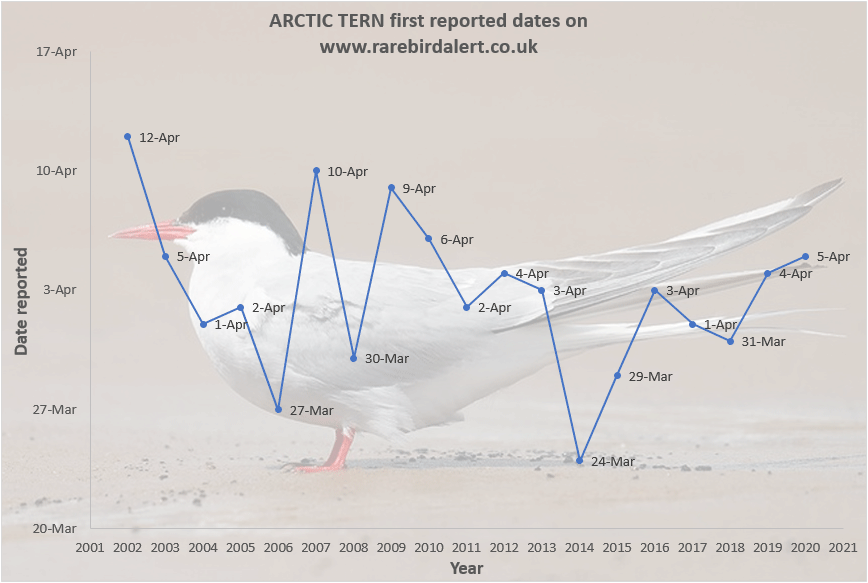
Black Tern
Median first report 2002-2020: 12 Apr
This year's first report: 18 Apr - Attenborough NR, Nottinghamshire.
The arrival of this passage species begins in early April, often accompanied by Little Gulls during southeasterly winds. Black Terns used to nest in vast numbers, on the floating vegetation of the wild wetlands of East Anglia and the Fens, but 'improvements' to those areas as they were drained, led to a catastrophic terminal decline in the British breeding population. Some 50,000 pairs are still estimated to breed in Europe.
arrivals map - upload a photo - report a sighting - latest news reports
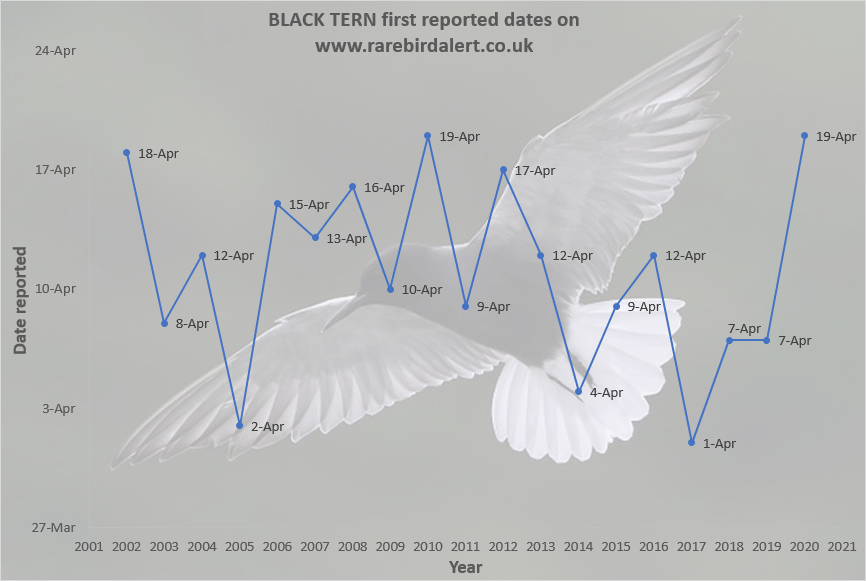
Night Heron
Median first report 2002-2020: 2 Apr
This year's first report: 7 Mar - Nanjizal, Cornwall.
Occasional over-wintering birds will inevitably cloud the 'arrivals' picture, as may escaped birds. There are usually 10-20 migrants recorded annually, but many are one-day birds. As with several other 'southern' heron and egret species, they are now breeding in England, albeit in very small numbers, for now.
arrivals map - upload a photo - report a sighting - latest news reports
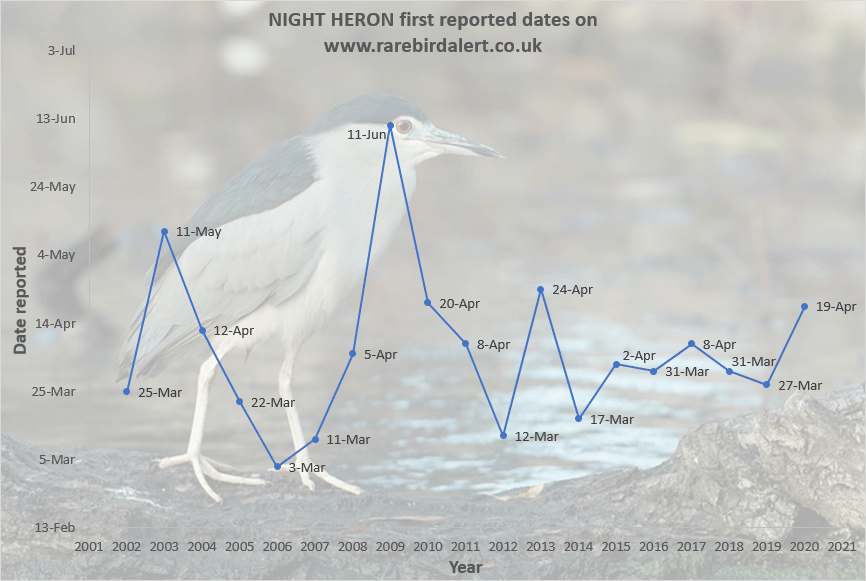
Purple Heron
Median first report 2002-2020: 3 Apr
This year's first report: 2 Apr - North Fambridge, Essex
It has long been predicted that this species will colonise the UK, but breeding attempts remain sporadic. The majority of the 20 or so Purple Herons that are recorded annually are seen in southern coastal counties and East Anglia, with a few further north along the east coast and in Wales. It is rarely seen in Scotland.
arrivals map - upload a photo - report a sighting - latest news reports
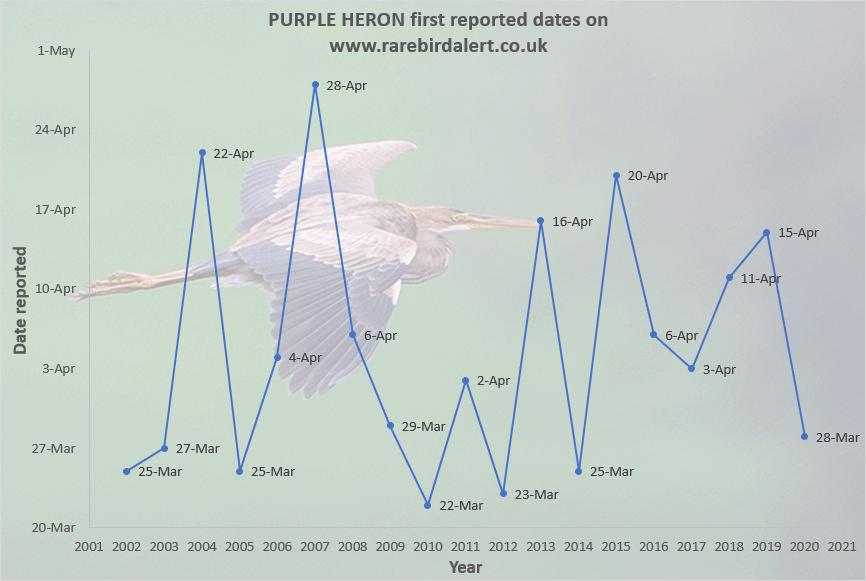
Osprey
Median first report 2002-2020: 4 Mar
This year's first report: 20 Feb - Orpington, London.
The Osprey on 20 February reported over Orpington in London, and later at Weir Wood reservoir, East Sussex, was not unprecedented, our fourth earliest first-report in the last 20 years, but almost two weeks earlier than the median first report. There were no further reports in 2021 until 1st March. The Osprey recolonisation of Scotland in the latter half of the 1900s was spectacular, and they now host the majority of UK birds with nearly 300 pairs. However, apart from passage and non-breeding birds, Osprey is still a scarce bird over much of the rest of Britain away from the ongoing re-introduction schemes at Rutland Water, Leicestershire, and at Poole Harbour, Dorset.
arrivals map - upload a photo - report a sighting - latest news reports
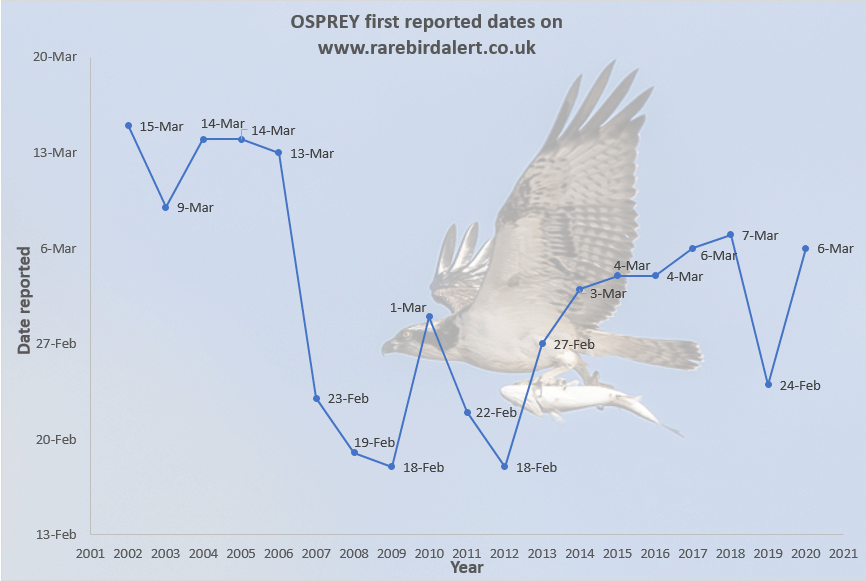
Honey Buzzard
Median first report 2002-2020: 20 Apr
This year's first report: 11 Apr - Copmanthorpe, North Yorks.
Many of the earliest reports of Honey Buzzard, before late April at least, probably never get into the County Bird reports unless they are backed up with photographic evidence. This is a rare breeding bird so in order to help protect against disturbance we only report migrant birds away from breeding areas, unless the site is an advertised raptor watchpoint.
arrivals map - upload a photo - report a sighting - latest news reports
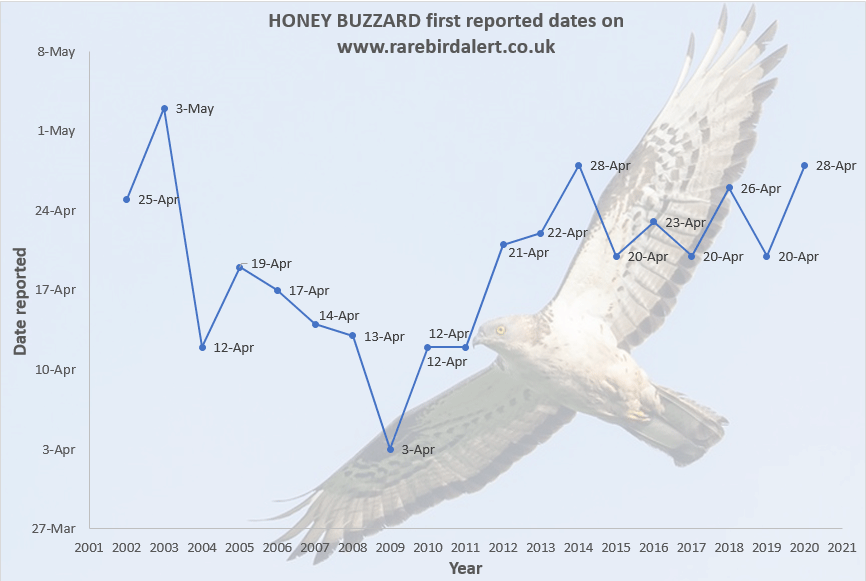
Hoopoe
Median first report 2002-2020: 14 Mar
This year's first report: 6 Mar - St.Agnes, Isles of Scilly.
Although some years there are wintering individuals, which can hinder working out the date of the first migrant, there was almost certainly a genuine arrival in late February 2003. In most recent years there are usually over 100 Hoopoes recorded in the UK, mostly in Spring, and mostly in southwest England. April is the month that most are found.
arrivals map - upload a photo - report a sighting - latest news reports
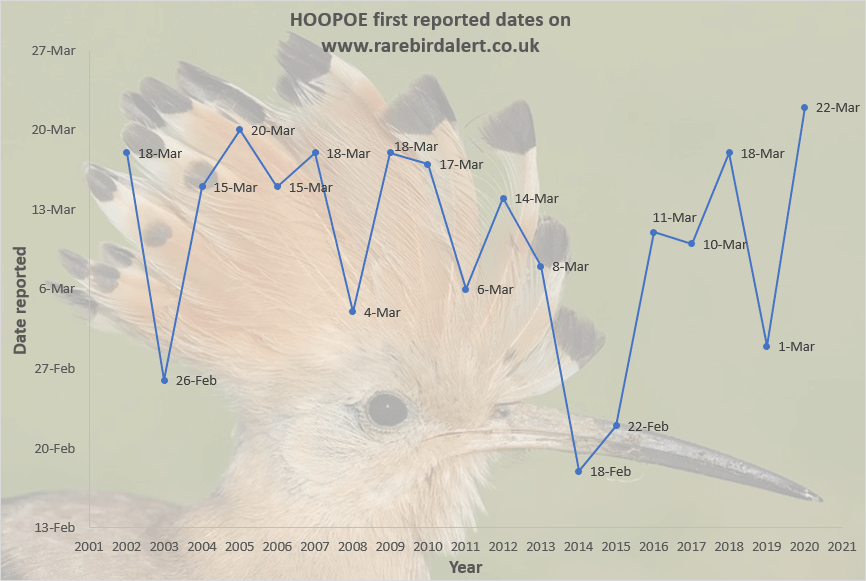
Hobby
Median first report 2002-2020: 28 Mar
This year's first report: 20 Mar - Linford Nature Reserve, Great Linford, Bucks.
A very early bird was reported near Welwyn Garden City on 20th March this year at Linford NR. Early arrivals are typically in late March and the first few days of April, and may even coincide with the first dragonflies in warm years, but most Hobbies are not here until much later in April or early May. This species has increased dramatically since the 1970s and there are now estimated to be over 2,000 breeding pairs in Britain, with around 50,000 in Europe in total.
arrivals map - upload a photo - report a sighting - latest news reports
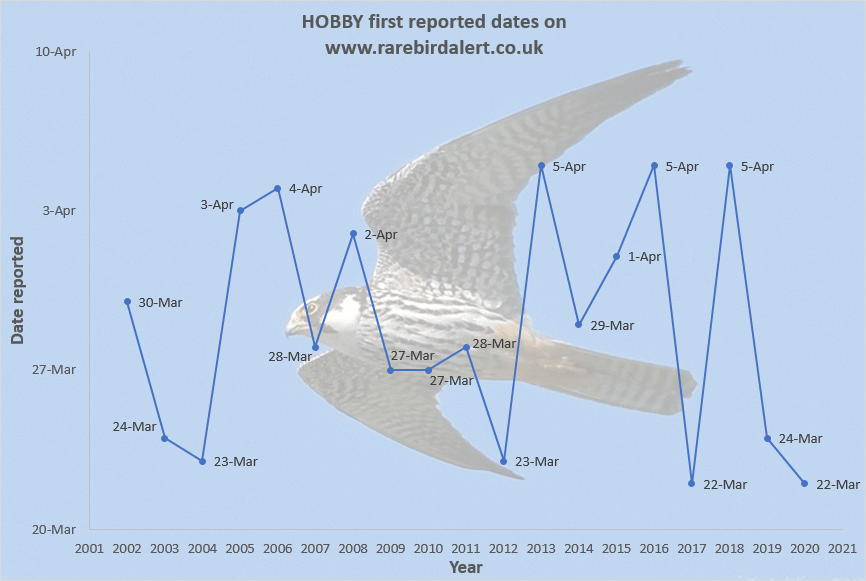
Golden Oriole
Median first report 2002-2020: 21 Apr
This year's first report: 24 Apr - The Garrison, St.Mary's, Isles of Scilly.
The maturing and subsequent harvest of the famous poplar plantations at Lakenheath, Suffolk, resulted in the loss of a popular and well visited breeding colony. However, it is still a regular if declining Spring migrant, and some favoured coastal localities, most especially in southwest England, such as the Isles of Scilly, record this species nigh-on annually. It never fails to amaze how even the most dramatic black-and-yellow individuals are often able to conceal themselves in sparse foliage.
arrivals map - upload a photo - report a sighting - latest news reports
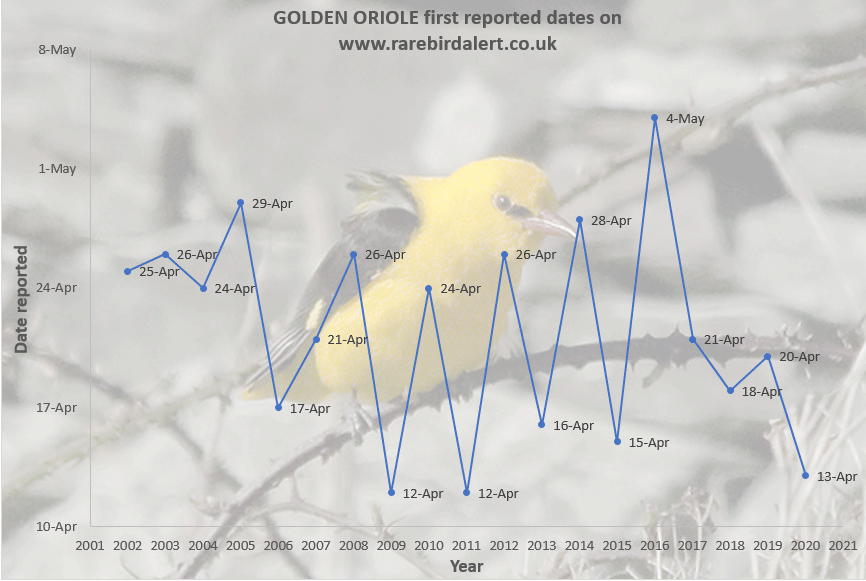
Sand Martin
Median first report 2002-2020: 28 Feb
This year's first report: 19 Feb - Cardiff Bay, Glamorgan.
First reported in 2021 on 19 February in Glamorgan, south of Cardiff at Cardiff Bay. This is our 4th earliest record and over a week earlier than the median. The UK population of 100-200 thousand pairs accounts for some 4% of a European population estimated at around 1/3 million pairs. They are, like many, but not all, other species, arriving earlier, and a recent study of Shropshire migrant records show Sand Martins now arrive an incredible 16 days earlier on average than they did a century ago.
arrivals map - upload a photo - report a sighting - latest news reports
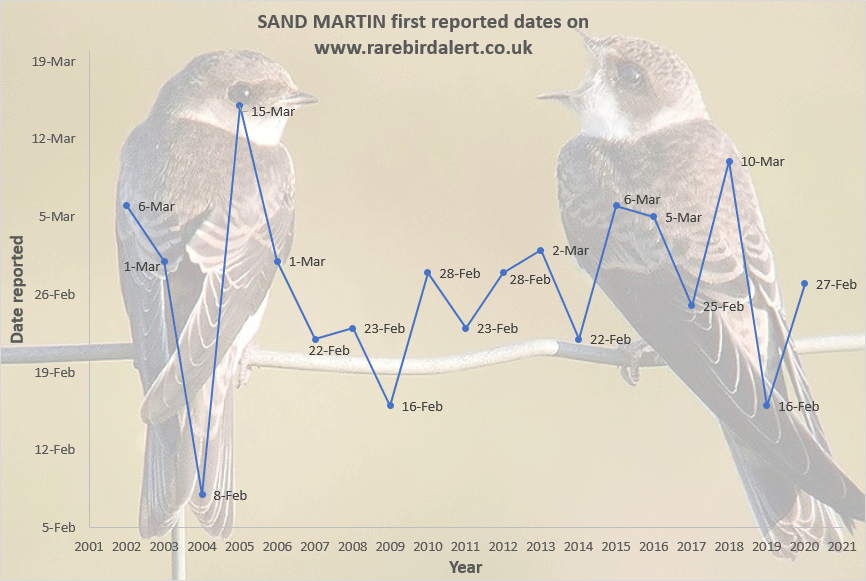
Swallow
Median first report 2002-2020: 23 Feb
This year's first report: 16 Feb - Ruan Minor, Cornwall.
First reported in 2021 on 16th February at Ruan Minor, near St.Buryan in Cornwall, several days ahead of the median. However, wintering birds, particularly in the south-west, increasingly cloud the analysis of arrival dates, and typical migration is from mid-March to mid-May. The UK population, of around 3/4 million pairs is in decline. There are estimated to be around 20-25 million pairs in Europe as a whole.
arrivals map - upload a photo - report a sighting - latest news reports
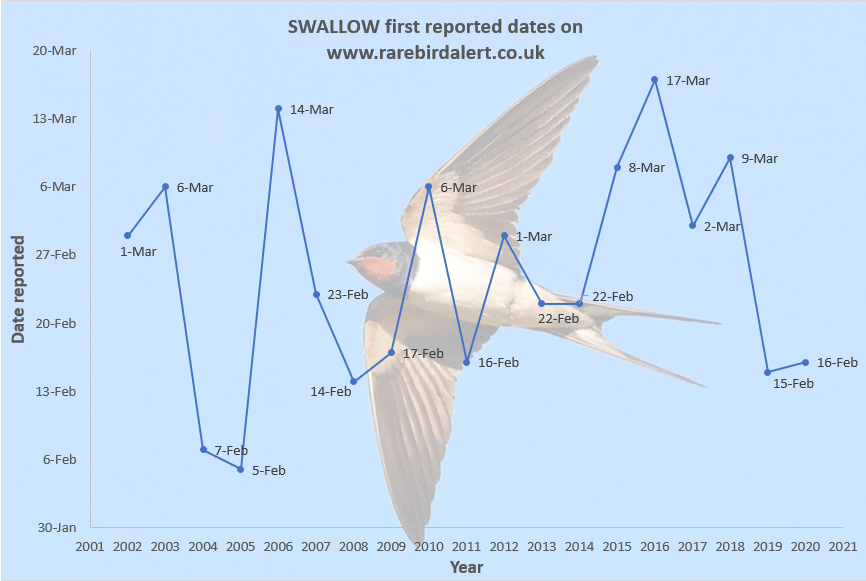
House Martin
Median first report 2002-2020: 8 Mar
This year's first report: 27 Feb - Long Sutton, Lincolnshire.
First reported in 2021 on 27th February at Long Sutton, Lincolnshire, several days ahead of the median over the last 20 years. There are estimated to still be around half a million pairs in the UK, and some 15 million or so pairs in Europe, but the population has been in continuous decline in recent decades.
arrivals map - upload a photo - report a sighting - latest news reports
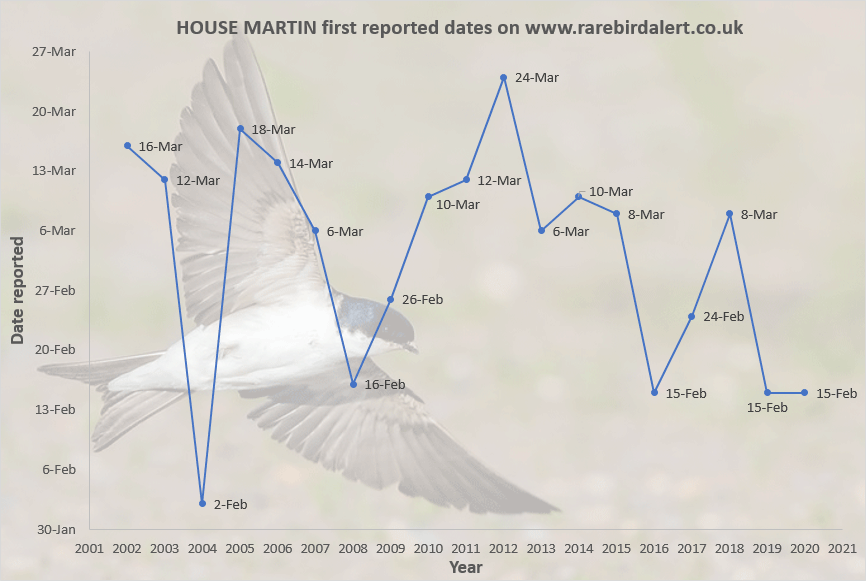
Wood Warbler
Median first report 2002-2020: 10 Apr
This year's first report: 7 Apr - Coldwaltham, West Sussex.
Birds reported at the end of March are very much outlying records, with birds normally trickling in during early April, and most have arrived by the beginning of May. Since the turn of the century there has been a dramatic decline in the British breeding population, which is now probably less than 6,000 pairs.
arrivals map - upload a photo - report a sighting - latest news reports
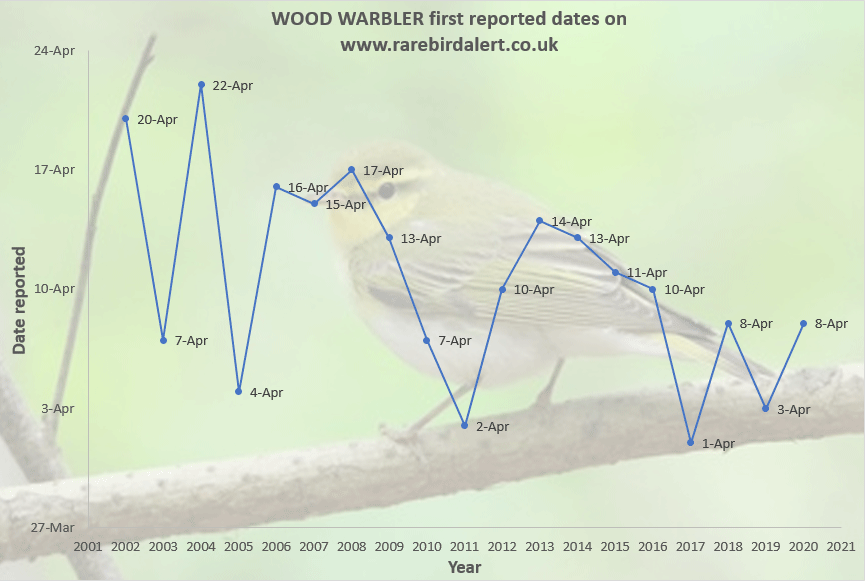
Willow Warbler
Median first report 2002-2020: 12 Mar
This year's first report: 4 Mar - Portland, Dorset.
Unless they are singing, Willow Warblers are not necessarily an easy identification for inexperienced observers, and that may account for some reports of this species. The first few are nearly always here by the 3rd week of March, and most have arrived by mid-April. The species has declined in the UK since WWII, with that decline accelerating in recent decades. Recent estimates give the population at a little over 2 million pairs. Willow Warblers, like many other species, are arriving earlier, and a recent study of Shropshire migrant records show them arriving 10 days earlier on average than they did a century ago.
arrivals map - upload a photo - report a sighting - latest news reports
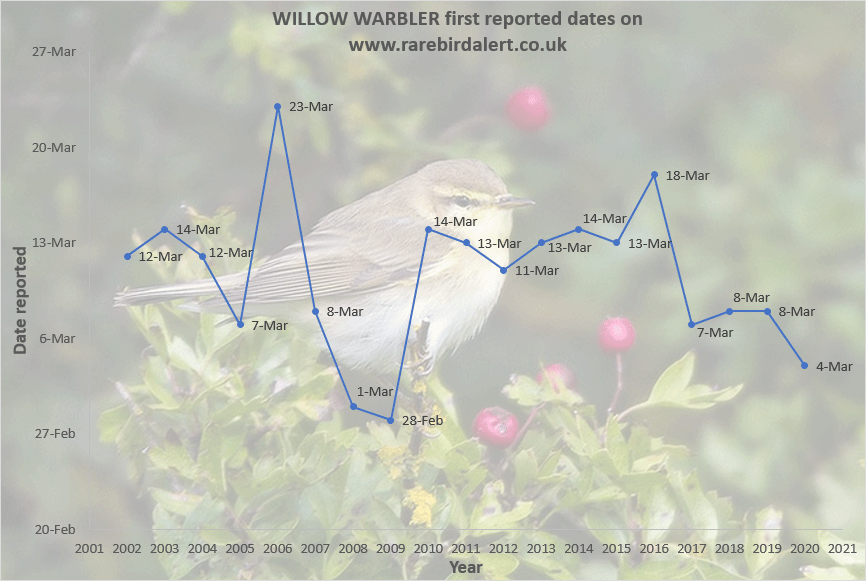
Sedge Warbler
Median first report 2002-2020: 24 Mar
This year's first report: 8 Mar - Christchurch, Dorset.
The first one or two are usually reported in late March, but typically there are very few until early April. If you cannot see the bird that is singing, persevere to try and get views as potentially similarly-sounding-songsters include Moustached Warbler, which has occurred in The Netherlands in recent years in both March and April, Paddyfield Warbler or White-spotted Bluethroat, all of which are possible here in early Spring. Further, more than one birder I know admits to having been caught out hearing, albeit briefly, what they thought was an early Sedge Warbler that turned out to actually be a 'dodgy' Blackcap. Although Sedge Warblers are in slow decline in Britain, they are still common, and recent estimates put their population at around a quarter of a million pairs.
arrivals map - upload a photo - report a sighting - latest news reports
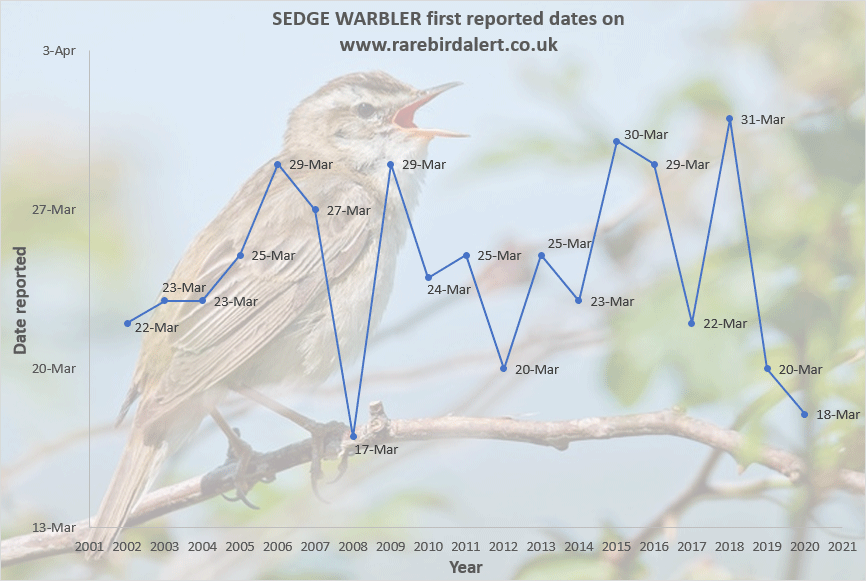
Reed Warbler
Median first report 2002-2020: 1 Apr
This year's first report: 30 Mar - Ham Wall RSPB, Somerset.
Occasionally birds are reported overwintering, such as the individual in Leyton, London, throughout November and December 2014. The first reports of migrant birds are generally not until the very end of March, or early April. Interestingly, their eye colour often changes as they get older: First year birds have a dark iris, changing to olive-brown when they are adult. The population is increasing in recent years, with some 130,000 pairs recently estimated in Britain.
arrivals map - upload a photo - report a sighting - latest news reports
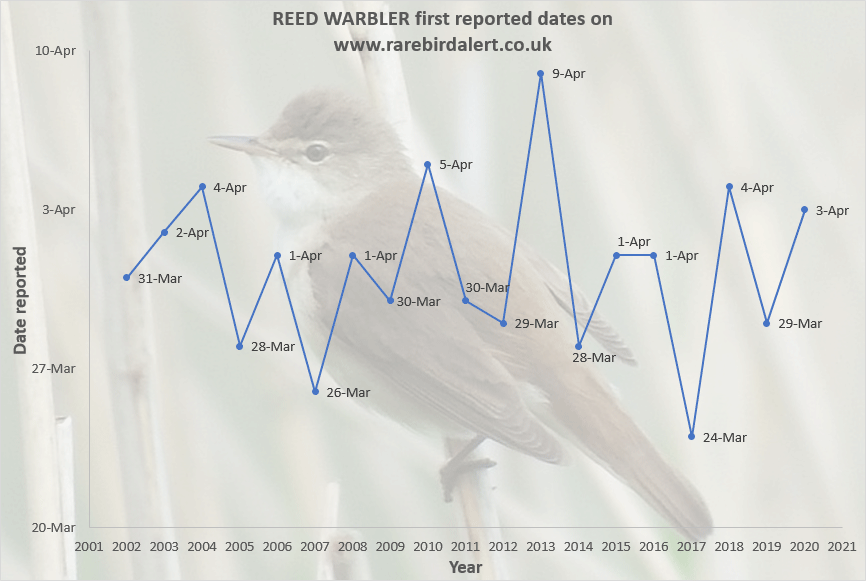
Grasshopper Warbler
Median first report 2002-2020: 2 Apr
This year's first report: 30 Mar 2021 - Christchurch, Dorset.
Small numbers arrive in March but there's an increased chance of hearing newly arrived reeling birds from about a week into April. When ageing ears can no longer hear the high pitched song of this species, the similar sounding, but lower pitched song of the rare Savi's Warbler can still be heard. A serious decline in the UK in recent decades, with the population recently estimated at just some 12,000 pairs.
arrivals map - upload a photo - report a sighting - latest news reports
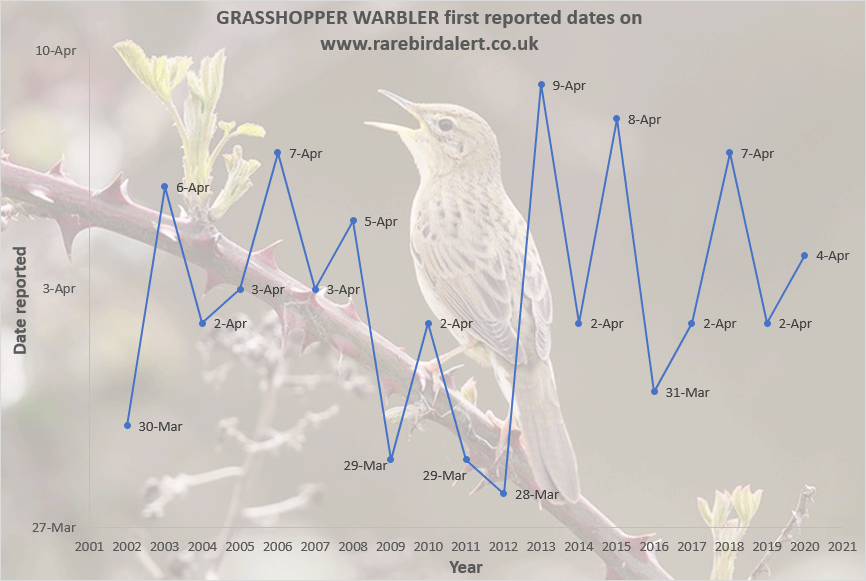
Garden Warbler
Median first report 2002-2020: 3 Apr
This year's first report: 31st Mar 2021 - Linford Gravel Pits, Buckinghamshire.
Winter records are not unknown, indeed there was one at Kilnsea, Yorkshire, in December 2020. Mainly arriving from mid-April, when one can re-acquaint differentiating their song from the somewhat similar sounding Blackcap. Still a fairly common bird, recent estimates put the British poulation at around 150,000 pairs.
arrivals map - upload a photo - report a sighting - latest news reports
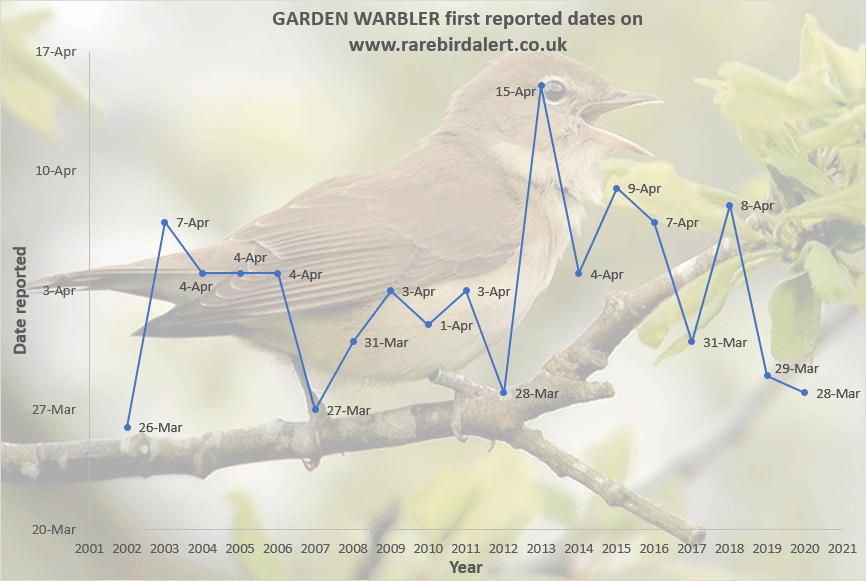
Lesser Whitethroat
Median first report 2002-2020: 2 Apr
This year's first report: 31 Mar 2021., Lakenheath Fen RSPB, Suffolk
Increasingly, the migrant picture is clouded by the occasional overwintering bird, which often prove to be of eastern forms. For example, one in a garden in Elvington, Yorkshire, in mid January had previously been trapped and ringed at Bempton Cliffs RSPB in October 2020, and had been confirmed by DNA analysis to be of the form blythi, Siberian Lesser Whitethroat. Unique amongst British warblers, Lesser Whitethroats migrate around the eastern end of the Mediterranean, rather than across the western end. A recent increase in population puts it at around 80,000 pairs in Britain..
arrivals map - upload a photo - report a sighting - latest news reports
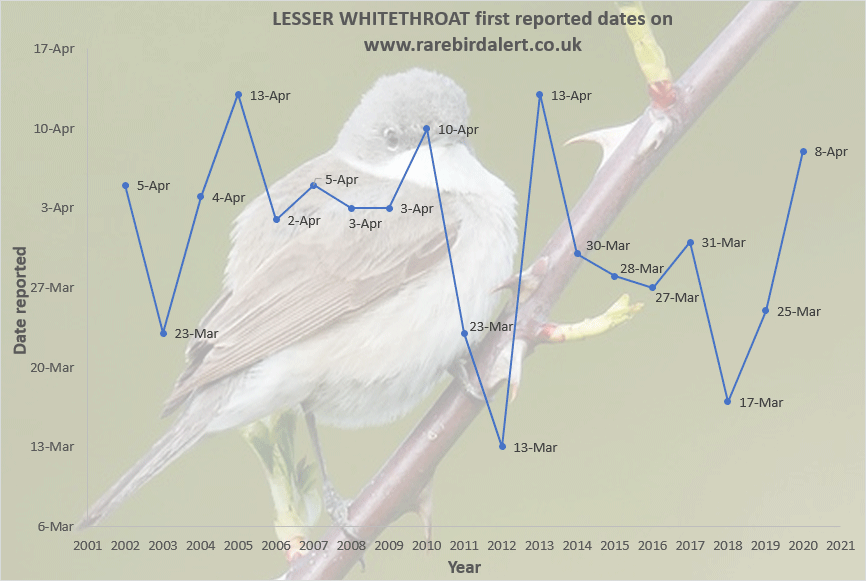
Whitethroat
Median first report 2002-2020: 30 Mar
This year's first report: 21 Mar - Bovey Tracey, Devon.
Wintering Whitethroats are very unusual, although one was reported in Bedfordshire in early Feb 2021. The very earliest migrants arrive in March, as shown in the chart. The population is still recovering after a massive drop due to the drought in the western Sahel in the late 1960s. Recent estimates put the British population at just over a million pairs.
arrivals map - upload a photo - report a sighting - latest news reports

Ring Ouzel
Median first report 2002-2020: 5 Mar
This year's first report: 1 Mar - Lodmoor RSPB, Dorset.
One on 24th February 2021 on the East Yorkshire coast at Bempton could conceivably have overwintered, as one had been present at the site until Christmas Eve 2020. A small number of birds now over-winter in Britain, so it is not always easy to ascertain which of the early records are genuine spring arrivals. Ring Ouzels are in decline, with recent estimates showing the British population at around 7,000 pairs.
arrivals map - upload a photo - report a sighting - latest news reports
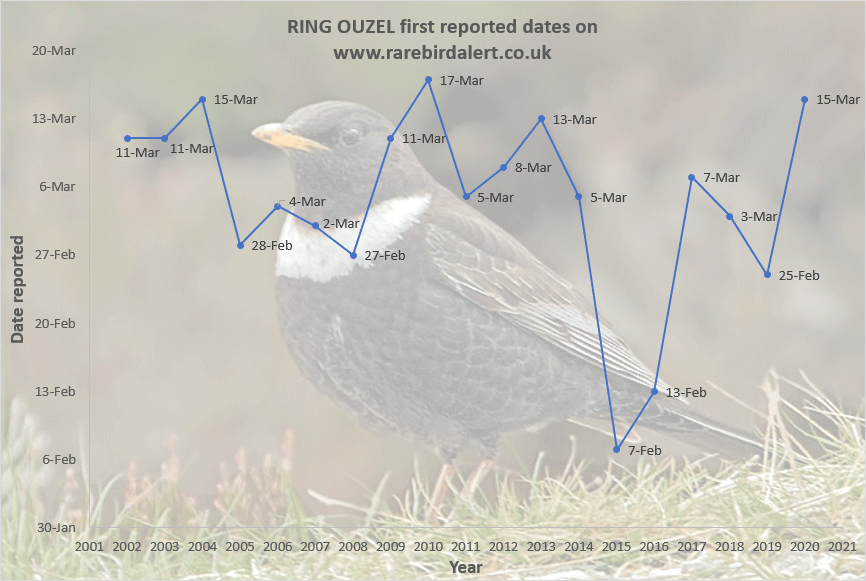
Spotted Flycatcher
Median first report 2002-2020: 17 Apr
This year's first report: 24 Apr - Porth Hellick, St.Mary's, Isles of Scilly.
Although very occasionally reported before mid April, it is not until that time that this species is likely to be found, and any reports in the first half of April, or earlier, would ideally be accompanied by a photograph for the local County Recorder to be able to accept them as genuine. The catastrophic decline of Spotted Flycatcher in the UK in just a few years is well documented, a decline that is painfully obvious whilst researching the reports to RBA over the past two decades: at the turn of the century they were still only "uncommon". Indeed, look back to 2001 to see a report of no less than 51 in Chantry Park, Ipswich.
arrivals map - upload a photo - report a sighting - latest news reports
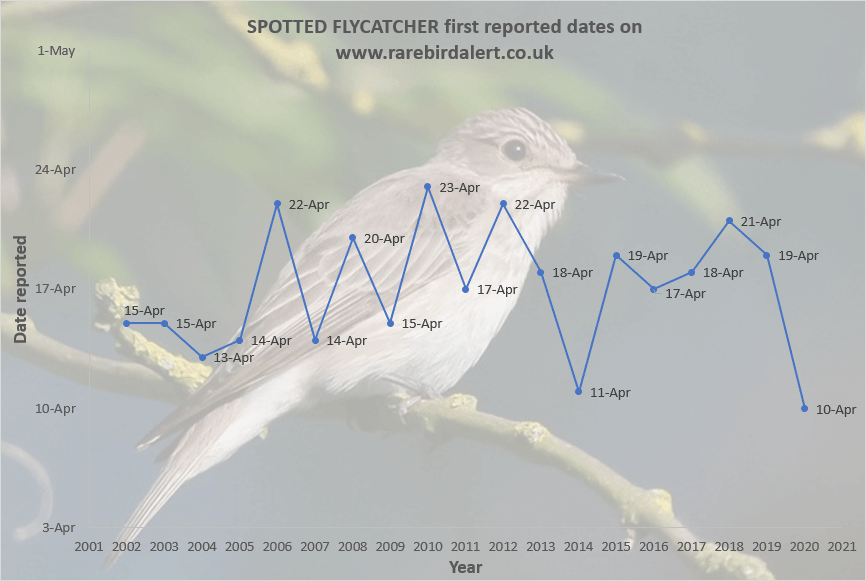
Bluethroat
Median first report 2002-2020: 31 Mar
This year's first report: 12 Apr - Carr Vale Nature Reserve, Derbyshire.
Bluethroat occurences in the UK are on the decline, with recent records averaging under 100 per year, less than 40% of the numbers recorded in the 1980s. The earliest arrivals are of the White-spotted form that breed in Central and Southern Europe, with the more northerly breeding Red-spotted birds being about a month later. Very occasionally, Bluethroats overwinter in the UK, such as one on North Ronaldsay, Orkney in the winter of 2017/18.
arrivals map - upload a photo - report a sighting - latest news reports
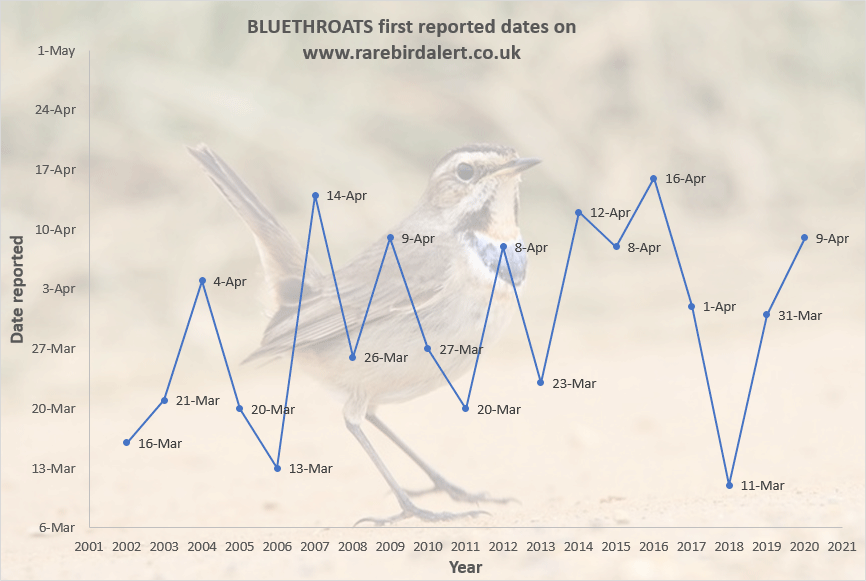
Nightingale
Median first report 2002-2020: 4 Apr
This year's first report: 29 Mar - Fordwich, Kent.
First reports at the end of March are very few, and are often unconfirmed, with the first ten days of April being more typical. By mid April males are establishing territories and starting to deafen all-comers as they attempt to attract migrating females out of the night sky. It's a great shame that the scrub and thickets that they depend on is such a diminishing habitat, cleared for a myriad of reasons. Recent estimates suggest there may be less than 5,000 pairs left in Britain. Vera Lynn would be even less likely to encounter one in Berkeley Square today.
arrivals map - upload a photo - report a sighting - latest news reports
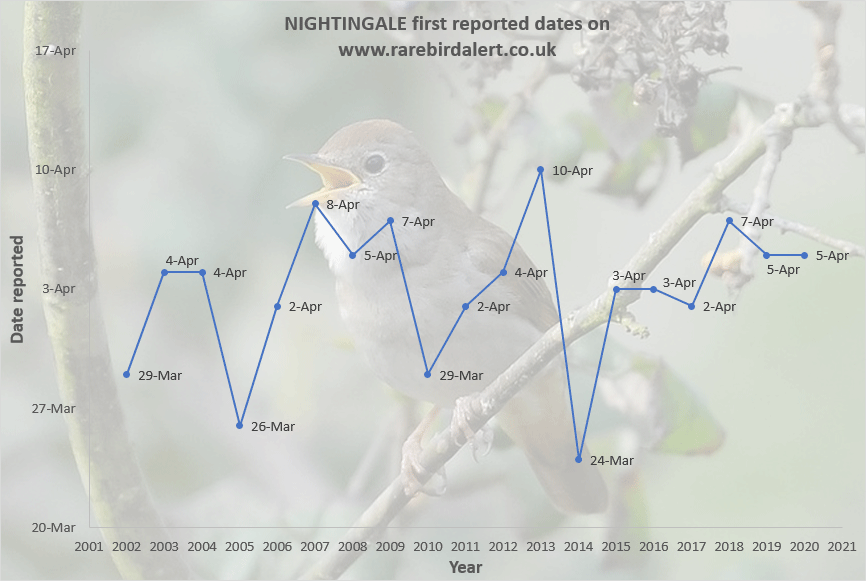
Pied Flycatcher
Median first report 2002-2020: 1 Apr
This year's first report: 30 Mar 3021 - Wyre Forest, Worcestershire
Encountering a dramatic black and white male Pied Flycatcher is one of the treats of Spring birding, and they can be found from the last days of March. I have enduring memories of my first, which was in Kew Gardens, London, on a YOC (Young Ornithologists Club) Local Leaders outing some 50 years ago. The breeding population increases of the late 1900s have been reversed, and recent estimates put the British population at less than 25,000 pairs.
arrivals map - upload a photo - report a sighting - latest news reports
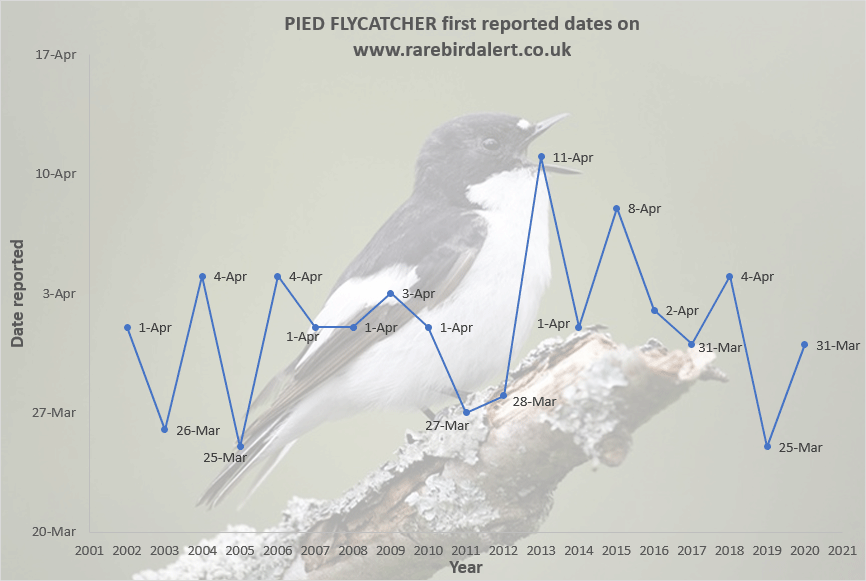
Redstart
Median first report 2002-2020: 22 Mar
This year's first report: 27 Mar - Dagenham Chase LNR, London.
Spring males, such as the one at Dagenham Chase on 27 Mar this year, are a joy to observe, and with good views are unmistakable. Early arrivals are recorded in late March most years but the majority arrive from early April. A notable winter record is of one at Wormwood Scrubs, London, in 2006. The British population has declined this century, with a recent estimate of 135,000 breeding pairs.
arrivals map - upload a photo - report a sighting - latest news reports
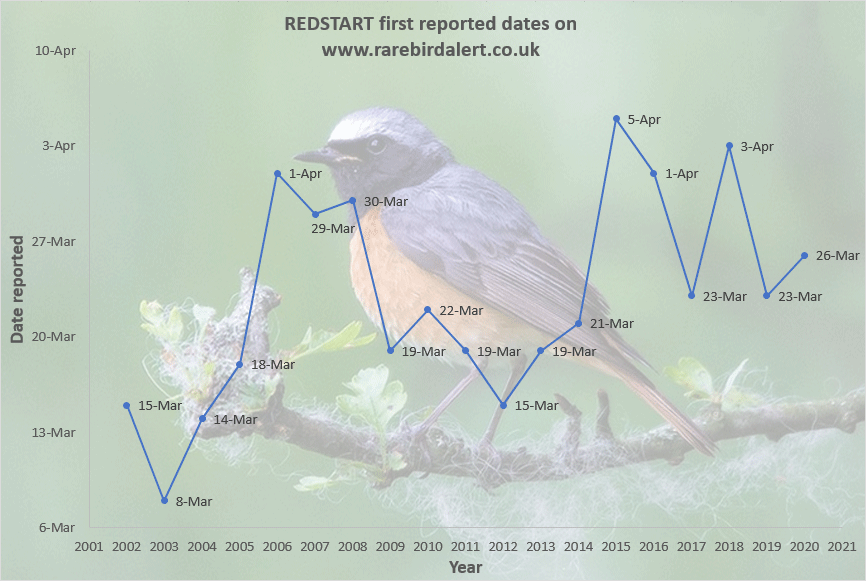
Whinchat
Median first report 2002-2020: 1 Apr
This year's first report: 25 Mar 2021 - BerryHill Fields NNR, Staffordshire.
March Whinchats are very unusual and should be photographed for the relevant County Recorder. Passage continues through April until late May. The British population is in noticeable decline, with a recent estimate showing there could be as few as 20,000 pairs left.
arrivals map - upload a photo - report a sighting - latest news reports
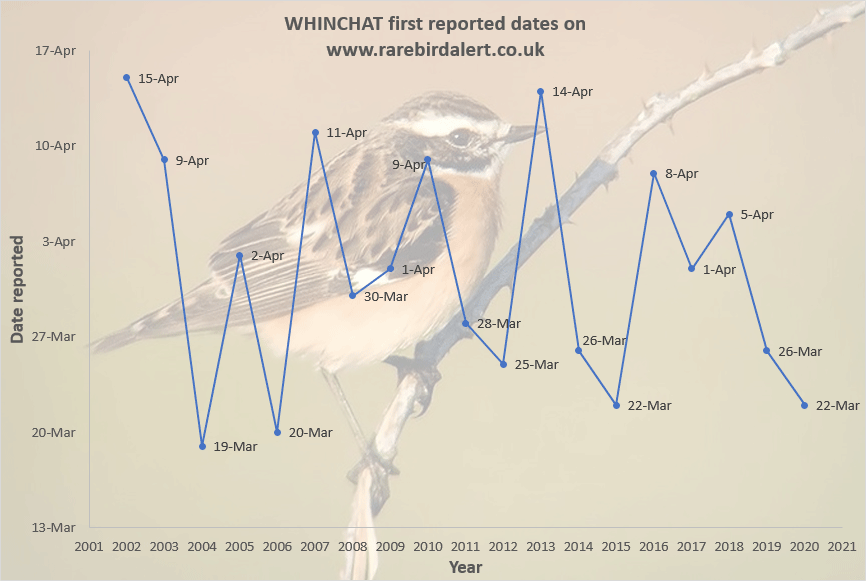
Wheatear
Median first report 2002-2020: 28 Feb
This year's first report: 10 Feb 2021 - West High Down, Isle of Wight.
One photographed on the Isle of Wight on 10 February 2021 is one day later than our earliest-ever first report. The spring passage of this species is protracted, and birds migrating later in the spring are likely to be heading to the highest latitudes, such as those making the long journey over the North Atlantic to Greenland. Unfortunately the British population of this species continues to decline, with recent estimates giving only between 120,000 - 220,000 pairs in 2016.
arrivals map - upload a photo - report a sighting - latest news reports
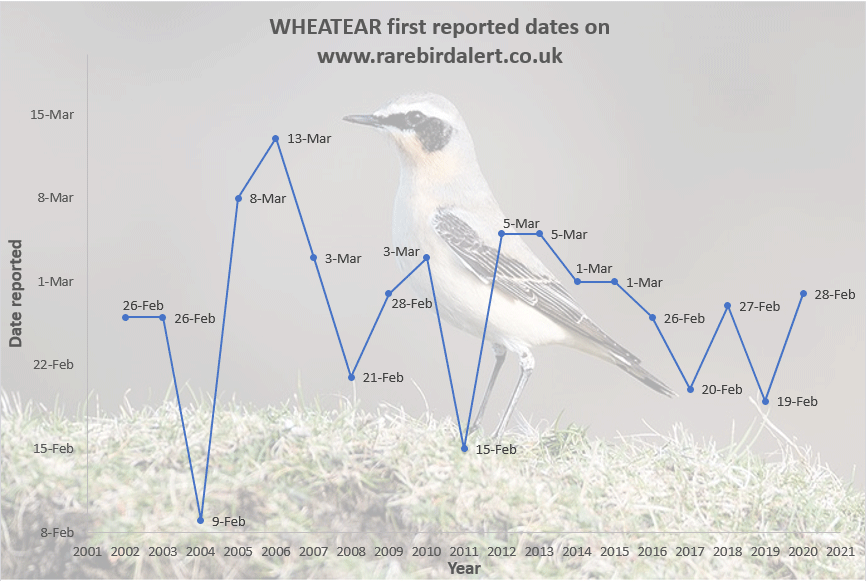
Yellow Wagtail
Median first report 2002-2020: 20 Mar
This year's first report: 23 Mar 2021 - Elmley NNR, Kent.
Any Yellow Wagtail before the 3rd week of March is rather exceptional. Although mid-winter records are not unheard of, the experience of recent years is that most yellow wagtails present here during the winter are actually Eastern Yellow Wagtails. The British breeding population continues to show a decline, with only about 20,000 pairs in 2016.
arrivals map - upload a photo - report a sighting - latest news reports
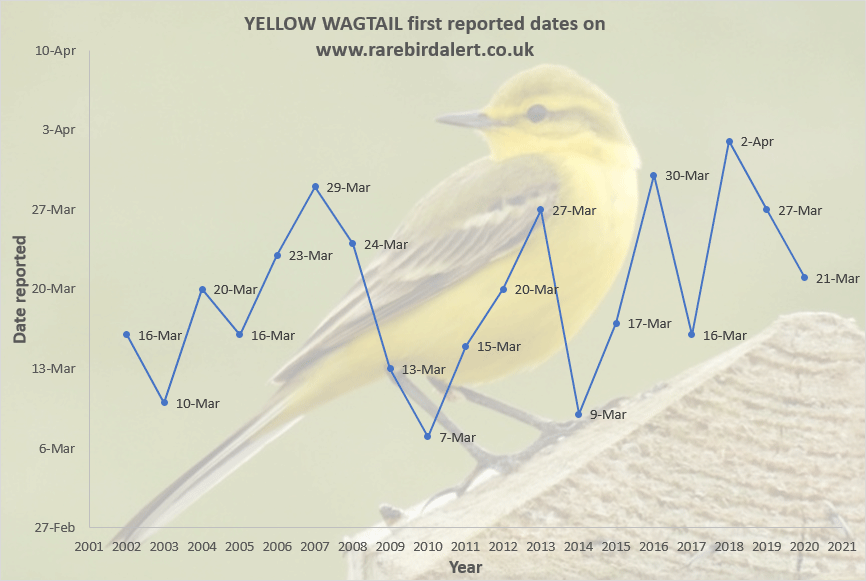
Blue-headed Wagtail
Median first report 2002-2020: 6 Apr
This year's first report: 29-Mar-2021 - Southease, East Sussex.
Blue-headed Wagtail - the nominate subspecies of Yellow Wagtail that breeds on the near Continent - typically arrives here later than the first British Yellow Wagtails. However, the identification of this subspecies typically relies on the bird being a male and being seen on the ground whereas many records of Yellow Wagtail here are of over-flying birds uttering their characteristic flight call and may actually relate to Blue-headed Wagtail.
arrivals map - upload a photo - report a sighting - latest news reports
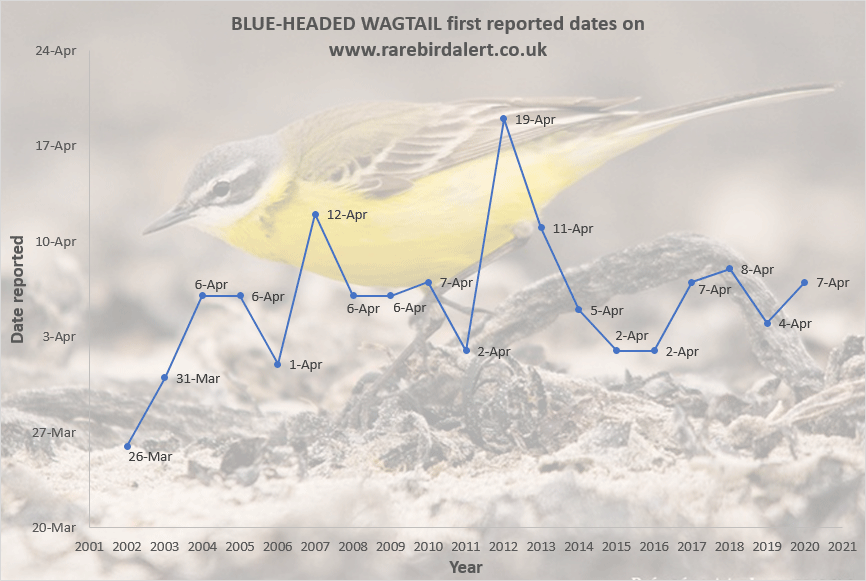
White Wagtail
Median first report 2002-2020: 28 Feb - Foreness Point, Kent
This year's first report: 21 Feb - Foreness Point, Kent and at Hove, Sussex.
These birds in 2021 were indeed early, a a whole week ahead of the median date. Although White Wagtail is a very rare breeder in the UK we are on the flightpath of the population that breeds in Iceland. The identification of this subspecies can be difficult and it is simultaneously over-recorded and overlooked.
arrivals map - upload a photo - report a sighting - latest news reports
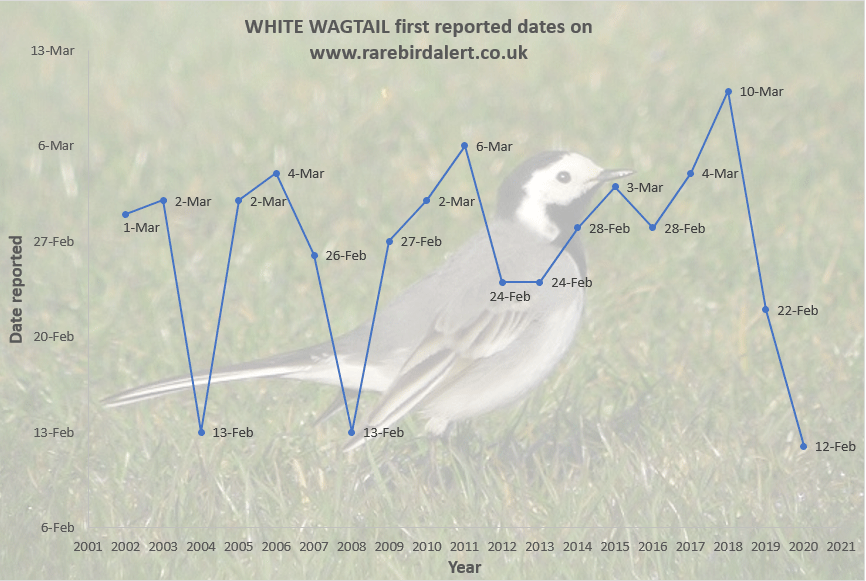
Tree Pipit
Median first report 2002-2020: 24 Mar
This year's first report: 14 Mar 2021 - Ventnor, Isle of Wight.
There are very few instances of Tree Pipits overwintering in Britain and the first dates are likely to relate to migrants arriving from Africa. Most records of this species are birds delivering their characteristic flight call whilst actively migrating. Prior to the vanguard arrival in April care must be taken identifying suspected Tree Pipits as singing Meadow Pipits have caused confusion in the past. The recent population decline has left the British population with as few as 66,000 pairs in 2016. (66k-120k).
arrivals map - upload a photo - report a sighting - latest news reports
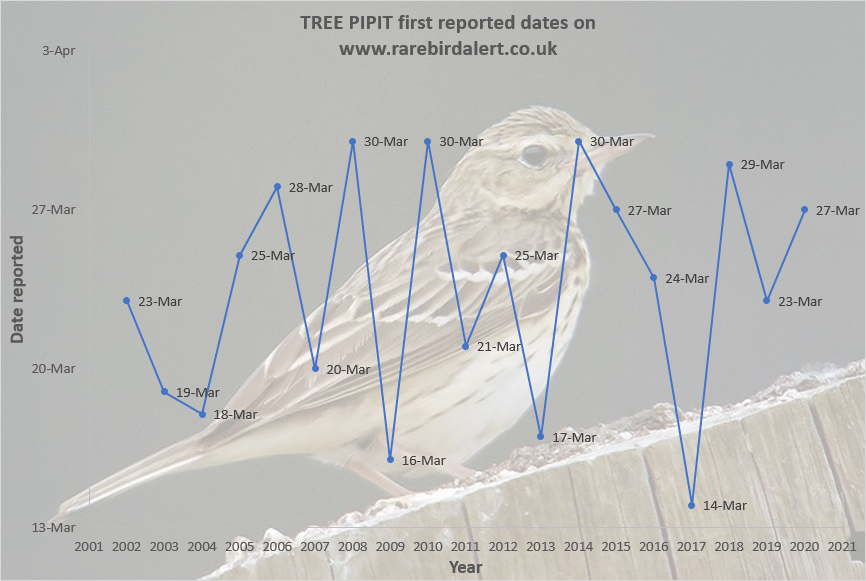
Common Rosefinch
Median first report 2002-2020: 5 May
This year's first report: 25 May - Loch of Spiggie, Shetland.
Occasionally birds winter in the UK, like one in Sheffield, South Yorkshire in 2006, so early spring records could refer to wintering birds. Typically, as a migrant, they are the last of our featured species to arrive with a median arrival date of 5th May; unsurprising given they have travelled here from the Indian Subcontinent. Annually about 150 are recorded in the UK, a significant increase since the 1970's and 80's. The Northern Isles account for a significant proportion of records.
arrivals map - upload a photo - report a sighting - latest news reports
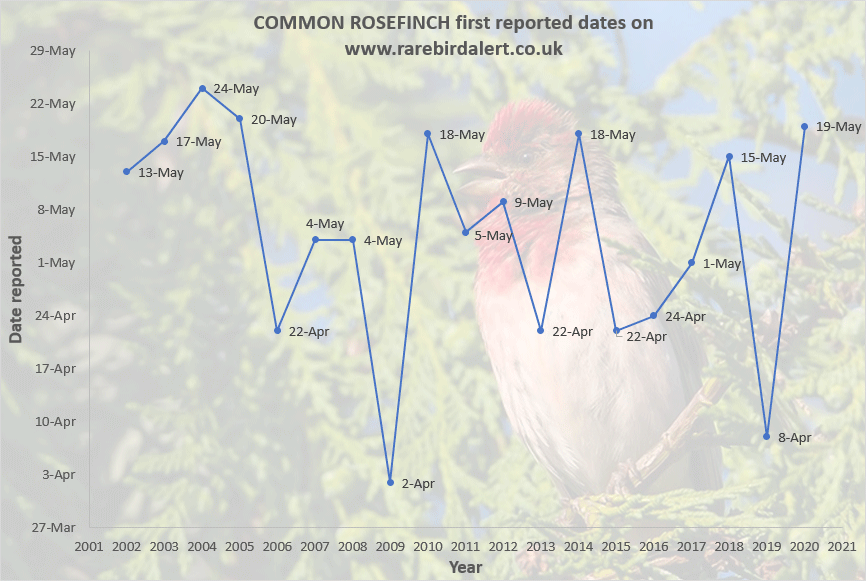
Share




